Trump to impose 100% tariff on China starting November 1
Introduction & Market Context
Flagstar Financial Inc. (NYSE:FLG) presented its Q2 2025 earnings slides on July 25, 2025, revealing plans to eliminate its bank holding company structure while continuing to navigate through financial challenges. The stock fell 6.18% to $11.31 following the presentation, reflecting investor concerns despite the company’s efforts to highlight its path to profitability.
The presentation comes after Flagstar reported an adjusted net loss of $(0.14) per share for Q2 2025, worse than the $(0.23) per share loss reported in Q1 2025, indicating continued pressure on the company’s financial performance.
Quarterly Performance Highlights
Flagstar reported a Q2 2025 adjusted net loss of $(52) million, or $(0.14) per diluted share. The company generated $496 million in total revenue, comprising $419 million in net interest income and $77 million in non-interest income. Adjusted operating expenses totaled $488 million, while the provision for credit losses was $64 million.
As shown in the following quarterly performance summary:
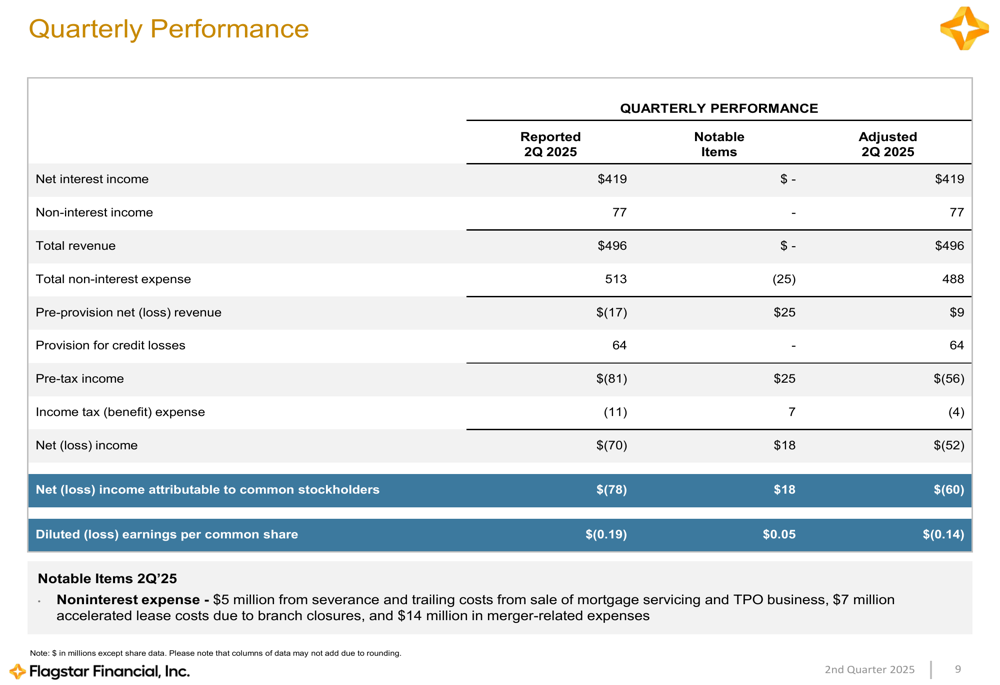
Operating expenses have been a key focus area, with adjusted operating expenses decreasing by $178 million or 28% year-over-year, and by $25 million or 5% quarter-over-quarter. This reflects the company’s ongoing efforts to streamline operations and improve efficiency.
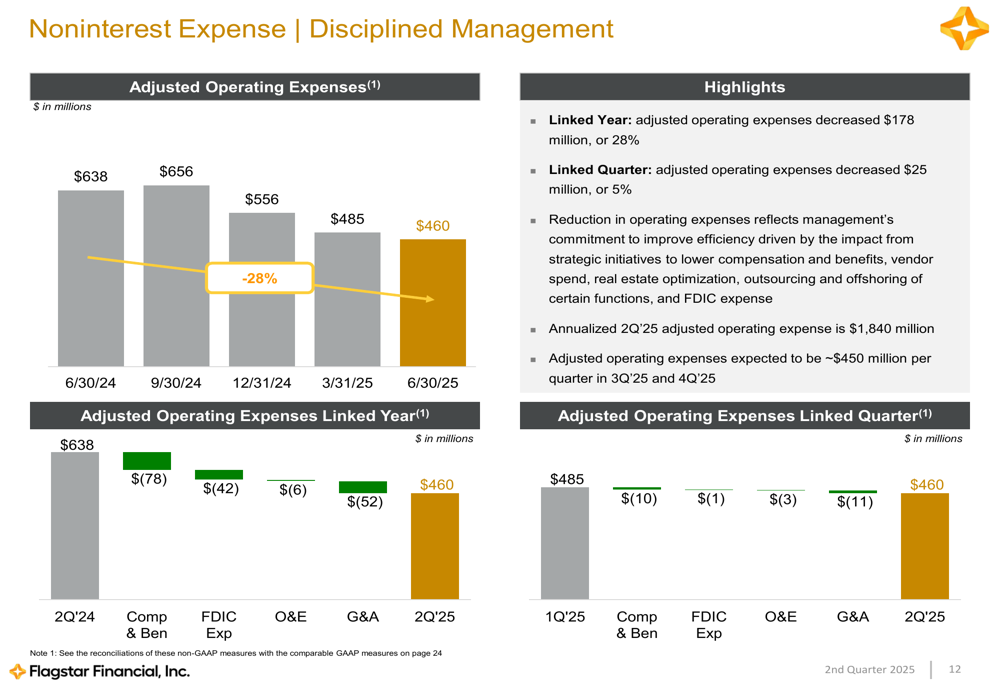
Strategic Initiatives
The most significant strategic announcement was Flagstar’s plan to eliminate its bank holding company structure, transitioning from Flagstar Financial, Inc. (Bank Holding Company) to simply Flagstar Bank, N.A. The company expects this move to generate annual cost savings of approximately $15 million by streamlining managerial, operational, and administrative functions while reducing duplicative supervision and regulation.
As illustrated in the following organizational structure change:

The timeline for this transition includes issuing a preliminary proxy in August 2025, holding a shareholder meeting in October 2025, and completing the merger in the fourth quarter of 2025, subject to shareholder and OCC approval.
Commercial Banking Growth
Despite overall financial challenges, Flagstar highlighted significant momentum in its commercial banking business. New credit commitments in Q2 2025 increased by 80% to $1.9 billion, while new loan originations rose by 57% to $1.2 billion. The company added 36 new Commercial/Corporate/Specialized Industries relationships during the quarter.
The following chart illustrates the growth in C&I loan originations and commitments:
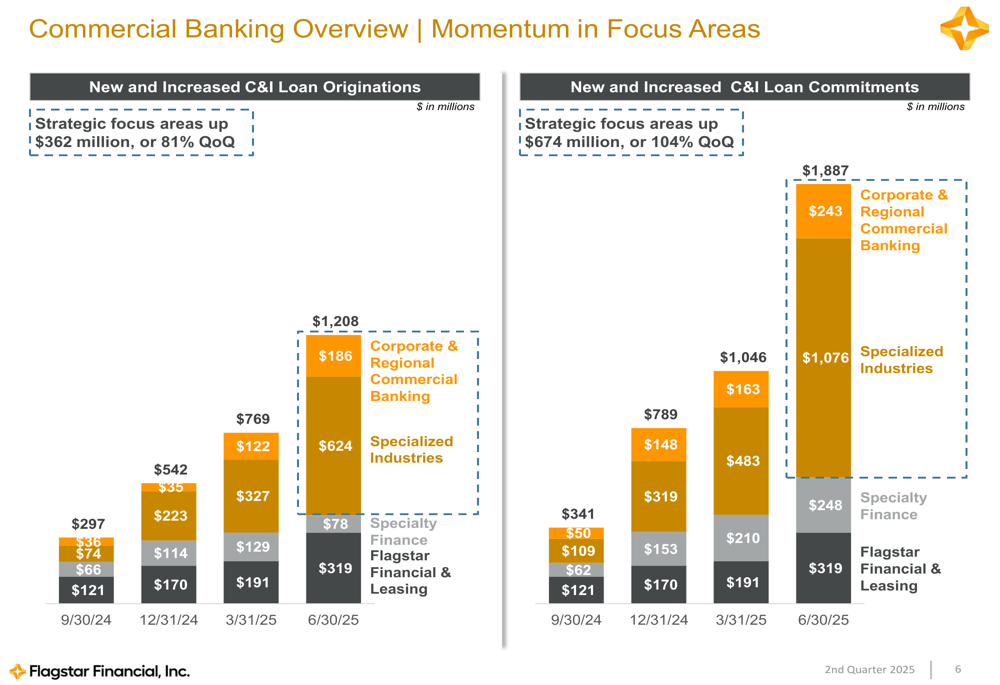
Flagstar’s commercial banking strategy focuses on two main areas: Specialized Industries (using a national model focused on specific industries) and Regional Commercial & Corporate Banking (building relationship-based banking). The company has added more than 100 new hires across commercial banking business and functions since June 2024 and plans to add 50 more commercial bankers throughout the remainder of 2025.
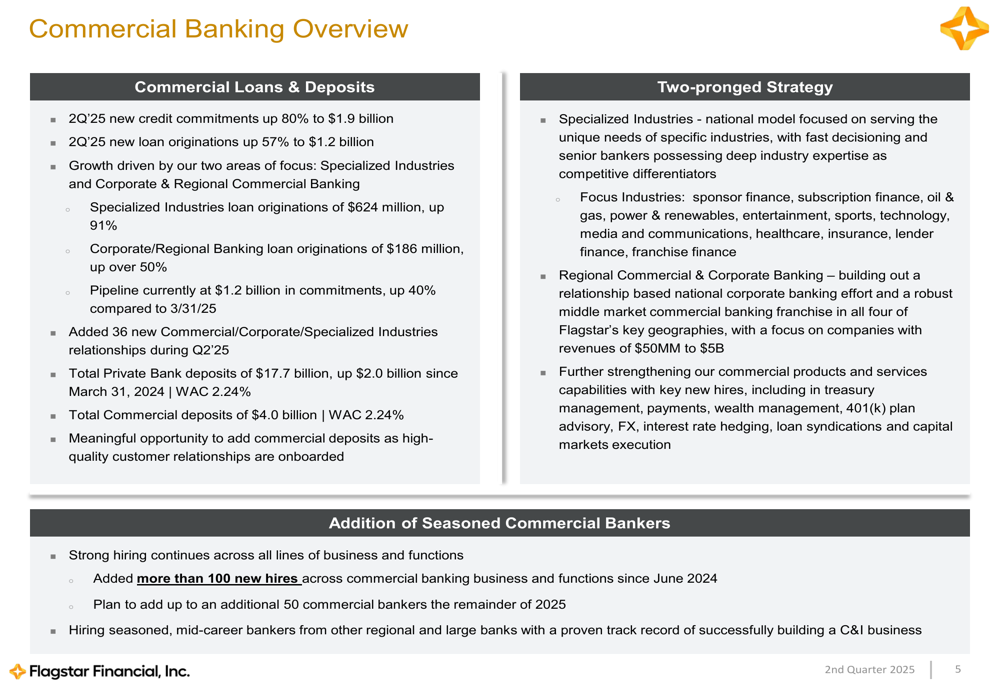
Balance Sheet Strengthening & Asset Quality
Flagstar has made significant progress in strengthening its balance sheet since the beginning of 2024. Key metrics show improvement across several areas, with the Common Equity Tier 1 (CET1) ratio increasing from 9.1% to 12.3%, placing it in the top quartile of its peer group.
The following chart demonstrates these balance sheet improvements:
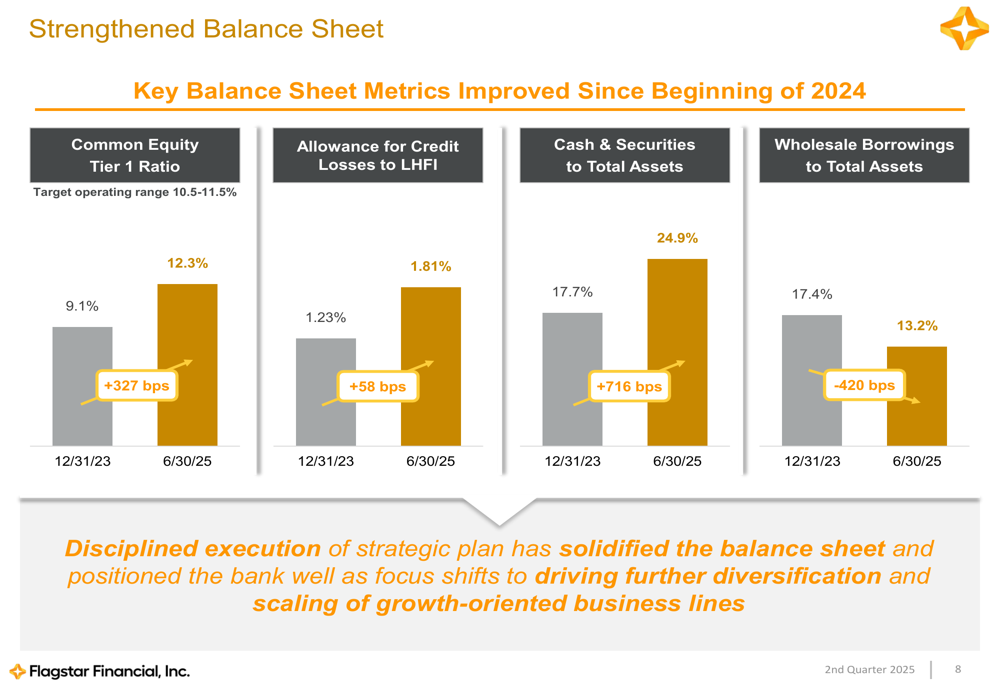
The company has been actively managing its commercial real estate (CRE) exposure, with total CRE balances decreasing by 16% from $47.7 billion at the end of 2023 to $39.8 billion as of June 30, 2025. CRE portfolio payoffs at par in Q2 2025 totaled $1.5 billion, compared to $840 million in Q1 2025.
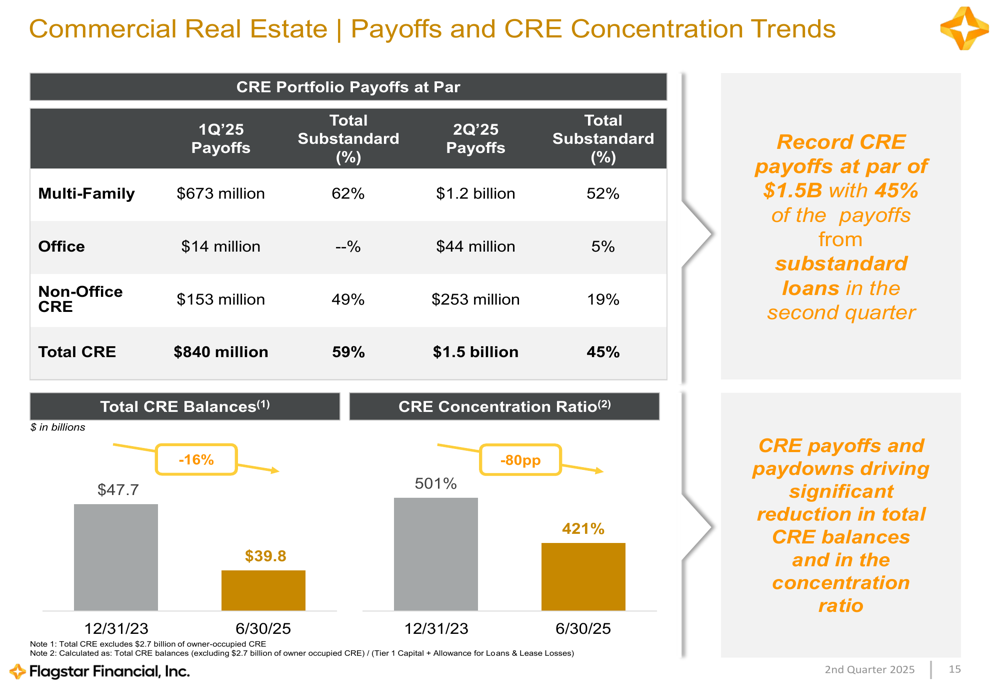
Multi-family exposure, which represents a significant portion of Flagstar’s loan portfolio, has been reduced by 12% from $33.9 billion on June 30, 2024, to $30.0 billion on June 30, 2025. The company maintains an allowance for loan and lease losses (ALLL) ratio of 1.68% for multi-family loans, which it notes is among the highest relative to peers.
Forward-Looking Statements & Forecast
Flagstar provided a detailed forecast update for 2025-2027, projecting a path to profitability. While the company expects a loss of $(0.40-0.35) per share in 2025, it forecasts earnings of $0.75-0.80 per share in 2026 and $2.10-$2.20 per share in 2027.
The forecast includes significant improvement in net interest margin (NIM), which is expected to expand from 1.85-1.95% in 2025 to 2.80-2.90% in 2027. This expansion is driven by declining funding costs, multi-family loans resetting higher by 300 to 350 basis points, growing higher-yielding commercial loans, and reduction in non-accrual loans.
As shown in the following forecast update:

The projected NIM improvement trajectory is illustrated below:
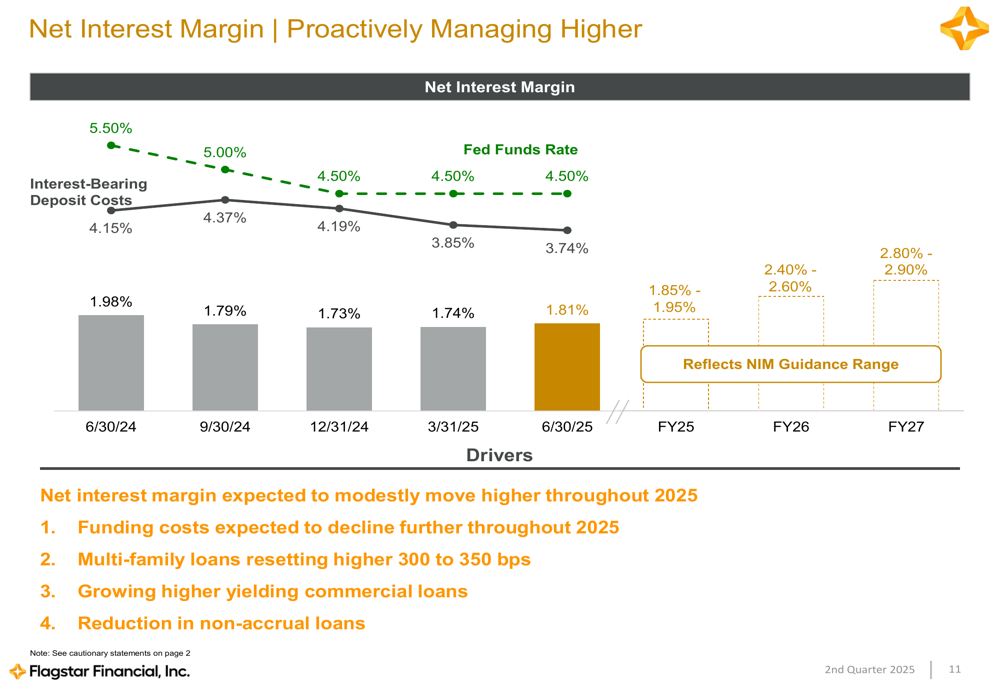
Market Reaction & Investment Profile
Despite the company’s efforts to highlight its path to profitability and strategic initiatives, Flagstar’s stock fell 6.18% to $11.31 following the presentation. This contrasts with the 1.18% increase seen after the Q1 2025 earnings announcement, suggesting investors may be concerned about the worsening quarterly loss and the extended timeline to profitability.
The presentation included an investment profile slide suggesting significant potential upside based on tangible book value (TBV) per share projections. At the current share price of $12.05, Flagstar trades below its projected TBV per share of $17.00-$17.50 for 2025.
In the Q1 2025 earnings call, CEO Joseph Otting had expressed confidence that the company would "return to profitability in the fourth quarter." However, the Q2 2025 presentation now indicates profitability will not be achieved until 2026, representing a shift in timeline that may have contributed to the negative market reaction.
As Flagstar continues its transformation journey, investors will be closely watching the execution of its holding company elimination plan, commercial banking growth initiatives, and progress toward the projected financial improvements in the coming quarters.
Full presentation:
This article was generated with the support of AI and reviewed by an editor. For more information see our T&C.
